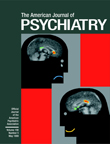To the Editor: In our recent study of the functional significance of anterior cingulate cortex abnormalities in schizophrenia, we reported that patients showed significantly less anterior cingulate cortex activation than matched comparison subjects during the Stroop selective attention task. Sean A. Spence, M.D., suggests that our use of an uncorrected value of p<0.01 for the contrast in the anterior cingulate cortex is not sufficiently stringent, proposing instead a threshold of p<0.001 as satisfactory. Dr. Spence proposes that our results actually disprove our hypothesis, suggesting instead that anterior cingulate cortex activation deficits are state-related deficits in schizophrenia.
The issue of choosing an appropriate threshold in analyzing neuroimaging data is a complex one that has been discussed in the
Journal (1). In his own formulation of this issue, Dr. Spence does not seem to make a distinction between an exploratory analysis and a hypothesis-driven one. In the case of an exploratory analysis, the p<0.001 threshold proposed by Dr. Spence may actually be insufficiently stringent, depending on the number of independent cells analyzed, although this threshold has become conventional for many neuroimaging groups. In the case of a hypothesis-driven study such as the one under discussion, it is completely reasonable to use a less stringent threshold because only a small subset of voxels is being considered in the analysis. This exemplifies the increased power afforded by a theoretically motivated and hypothesis-driven experimental design
(2). The abstract cited by Dr. Spence as providing empirical support of a p<0.001 threshold only addresses the exploratory analysis of positron emission tomography activation data and does not consider the analysis of hypothesis-driven experiments. Despite Dr. Spence’s admonitions to the reviewers of our article, this issue was, in fact, thoughtfully discussed during the peer review process, and this approach met the approval of the expert statistical reviewers for the
Journal. Of course, Dr. Spence should feel free to draw his own conclusions regarding our results, but we point out that in the same way that it is important to control for type I error in functional neuroimaging studies, it is also hazardous to draw strong theoretical conclusions in these studies on the basis of negative results. We feel that it would be particularly rash to propose a new theory (e.g., that anterior cingulate cortex activation deficit in schizophrenia is state related) based on the fact that group differences in the response in the current study were significant at a threshold of p<0.002 rather than p<0.001. Nonetheless, Dr. Spence’s theory is interesting, and we look forward to its being put to the test empirically in the near future.

